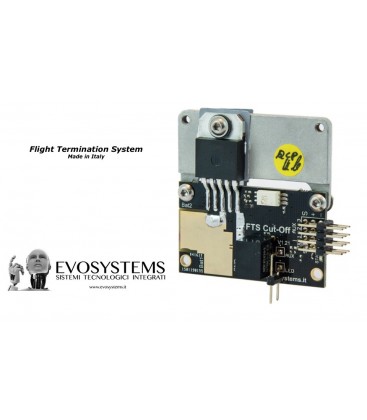No products
Flight Termination System V1.21

Advanced flight termination system for unmanned aircrafts
- Immediately cut your UAV's throttle at the flick of a switch
- Can support 150A (up to 300A peak)
- 5V to 34 V
- Lightweight
- Can be used used conjointly with the SAC remote
- Can still release a parachute even if there is a problem with the flight batteries
The following text is a slightly reworked translation from Google Translate, you can view the original description on the manufacturer website.
Before presenting the system it is necessary to make two assumptions:
- Our main goal is to bring the overall risk of failure to acceptable. It 'well known that zero risk does not exist, to obtain it, in substance should not bring the medium in flight.
- Normally must be regarded as the occurrence of a single failure at a time and not the combination of more of these.
One of the risks of failure of our systems, what they fear most ENAC (Italian FAA), is the "fly-away", to prevent this serious event, normally our UAV provide at least four solutions:
- In case of failure of the data link, the Automatic takeover of the radio link;
- In the event of failure of the radio link, the activation of the RTH or autopilot systems of similar emergencies;
- In the event of failure of avionics, if not present a real redundancy of this' last you must enable the FTS (Flight Termination System);
- In case of failure of the previous systems, the Crisis of FTS commonly called "cut-off", which must be necessarily controlled by a remote control or autonomous system dedicated dealing exclusively with emergency systems;
As can be seen, to get to the "fly-away" has already occurred before the failure of the system or more than one, then we are already in the context of remote events even if possible, and then in the "reasonable risk", but we wanted to go well ...
We had to include also the possibility of failure of the device or of the FTS LiPo same, preventing UAVprecipitate to cause one of the two elements mentioned.
With regard to LiPo, one of the characteristics of our device it is to be able to intervene in the event of failure (power failure / short circuit) of this imported element, which in these cases is isolated from the system, thus preventing also the second LiPo can follow the same fate plunging the middle.Obviously the reference is open to all media that include the presence of two LiPo and two FTS (one for LiPo), which in our opinion is a detail that should not be underestimated.
Our Form FTS is realized by taking advantage of two power switches in the solid state by more than 150A each, low dispersion, and that connected in parallel to bear a maximum load of 300A * for each LiPo, so widely over the usual range of absorption of our UAV does this ensure, in the context of "reasonable risk", the continuity of service even in the event of failure of one of the two power switches, thus avoiding that the medium can fall unintentionally.
As regards the power of the RX, this is directly through a BEC on the module and
upstream of LiPo. This particular configuration keeps the receiver powered even after the separation power of the UAV, allowing us to activate any other add-on modules of the emergency system.
The PWM signal sent from the RX system FTS, is then forwarded to a circuit filters it against interference or false signals, and only when it is certain that he received a correct sequence sends the command through an optocoupler.
This is one reason that allows us to define the device as "redundant"
The possibility that the FTS system from damage, for example in the event that followed to provide power to the system even after the termination command, would be considered a second concomitant failure, therefore, normally not covered;
We thought of that!
The causes that lead to a problem of this type, may result from:
- Failure of the autonomic TX / RX commands the termination;
- A failure to one of the power components, intended as a non-termination in providing power even when it was expected;
- Or an interference action of a device for radio disturbance, such as a jammer;
Let's analyze in detail some points to reduce the risk of failure at "reasonable":
- Can be connected to the PWM signal for the activation of the termination system, taking advantage of a free channel of the receiver RC-installed on the UAV, or by using a third receiver which will be in turn fed from the card FTS that is equipped with BEC 5V supply;
- During the pre-flight check of each mission, also check the proper functioning of the FTS system;
- Carry out a careful analysis of the risks from radiofrequency area of operations;
In the case of UAV double LiPo (with double module FTS) obviously the probability that such an event might occur on both FTS modules is actually very remote, in this case would be considered the THIRD failure consecutive event very unlikely and, in event were to occur on one of the two modules the autonomy of flight, it would reduce any case to about half.
Specifications and Connections
- - Input LiPo
- - Output to power-board
- - GND common
- - RX input - accepts signals PWM or PPM
- - Output AUX1, AUX2 ** and AUX3 for control of other utilities and add-on modules (eg. servo, LED, buzzer, parachute, etc ...)
Features summary
- Overload protection
- Current limiter
- Short-circuit protection
- Overtemperature protection
- Diagnostic feedback current load
- Electrostatic discharge (ESD)
Nameplate of solid state switches
- Load current (ISO) IL (ISO) 330A
- Operating voltage Vbb (on) 5 ... 34 V
- On-state restistenza Ron 2.5 mΩ
- Short circuit current limitation IL (SCr) 520 A
- Operating temperature -40 ° -: - + 150 ° C
- Power Dissipation Tc ≤ 25 ° C
- Thermal resistance (in open air) typ. 30 K / W - max. 35 K / W
Operating data Recommended
- Load current typ. 120A / 330A max
- Operating voltage ... 6S LiPo 3S (11,1V -: - 22,2V)
- Operating temperature -40 ° -: - + 100 ° C
- Input signals accepted: PPM / PWM
- Size in mm: 51 x 52 x 20 - weight 36g.
** AUX2 with PWM output inverted
| Total system weight (in ounces) | 1.3 |
| Operating voltage | 5V - 34V |
| Total system weight (in grams) | 36g / 1.3oz |
| Size (in centimeters) | 51mm x 52mm x 20mm |
| Height | 20mm |
| Width | 51mm |
| Length | 52mm |





